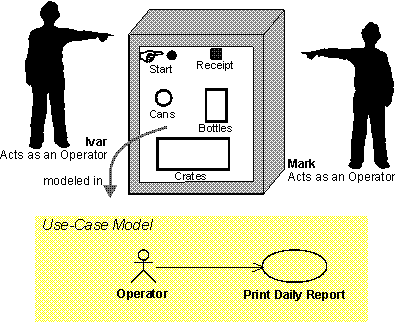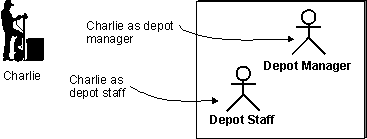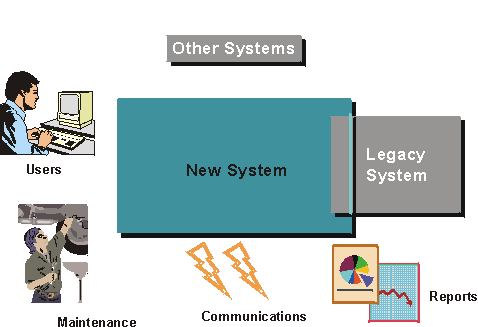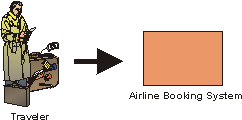Guidelines: Actor
Actor |
An actor instance is someone or
something outside the system that interacts with the system. An actor class defines a set of actor instances, in which each actor instance plays the same role in relation to the system. |
Topics
- Explanation
- How to Find Actors
- Actors Help Define System Boundaries
- Brief Description
- Actor Characteristics
Explanation 
To fully understand the system's purpose you must know who the system is for, that is, who will be using the system. Different user types are represented as actors.
An actor is anything that exchanges data with the system. An actor can be a user, external hardware, or another system.
The difference between an actor and an individual system user is that an actor represents a particular class of user rather than an actual user. Several users can play the same role, which means they can be one and the same actor. In that case, each user constitutes an instance of the actor.

Ivar and Mark are operators of a recycling machine. When they are using the machine each is represented by an instance of the actor Operator.
However, in some situations, only one person plays the role modeled by an actor. For example, there may be only one individual playing the role of system administrator for a rather small system.
The same user can also act as several actors (that is, the same person can take on different roles).

Charlie uses the Depot-Handling System primarily as Depot Manager, but sometimes he also uses the Depot-Handling System as ordinary Depot Staff.
How to Find Actors 

What in the system's surroundings will become actors to the system?
Start by thinking of individuals who will use the system. How can you categorize them? It is often a good habit to keep a few individuals (two or three) in mind and make sure that the actors you identify cover their needs. The following set of questions is useful to have in mind when you are identifying actors:
- Who will supply, use, or remove information?
- Who will use this functionality?
- Who is interested in a certain requirement?
- Where in the organization is the system used?
- Who will support and maintain the system?
- What are the system’s external resources?
- What other systems will need to interact with this one?
There are several different aspects of a system's surroundings that you will represent as separate actors:
- Users who execute the system's main functions.
Example:
For a Depot-Handling System, which supports the work in a depot, there are several categories of users: Depot Staff, Order Registry Clerk, Depot Manager. All these categories have specific roles in the system and you should therefore represent each one by a separate actor.
- Users who execute the system's secondary functions, such as system administration.
Example:
In a recycling machine used for recycling cans, bottles, and crates, Customer is the main actor, the one for whom the system is primarily built. Someone has to manage the machine, however. This role is represented by the actor Operator.
- External hardware the system uses.
Example:
A ventilation system that controls the temperature in a building continuously gets metered data from sensors in the building. Sensor is therefore an actor.
- Other systems interacting with the system.
Example:
An automated teller machine must communicate with the central system that holds the bank accounts. The central system is probably an external one, and should therefore be an actor.
Actors Help Define System Boundaries

Finding the actors also means that you establish the boundaries of the system, which helps in understanding the purpose and extent of the system. Only those who directly communicate with the system need to be considered as actors. If you are including more roles than that in the system's surroundings, you are attempting to model the business in which the system will be used, not the system itself.
Example:
In an airline booking system, what would the actor be? This depends on whether you are building a airline booking system to be used by a travel agent, or whether you are building a system to which the passenger can connect directly through Internet.

If you are building an airline booking system to be used at a travel agent, the actor would be travel agent. The traveler doesn't interact directly with the system, and is therefore not an actor

If you are building a booking system that will allow users to connect via the Internet, the traveler will interact directly with the system and is therefore an actor to it.
Brief Description 
The brief description of the actor should include information about:
- What or who the actor represents.
- Why the actor is needed.
- What interests the actor has in the system.
The brief description should be, at most, a few sentences long.
Example:
In the use-case model of the Recycling Machine, the three actors are briefly described as follows:
Customer: The Customer collects bottles, cans and crates at home and brings them back to the shop to get a refund.
Operator: The Operator is responsible for maintenance of the recycling machine.
Manager: The Manager is responsible for questions about money and the service the store delivers to the customers.
Actor Characteristics 
The characteristics of an actor might influence how the system is developed, and in particular how an optimally usable user interface is visually shaped. Note that if business workers corresponding to the actors are already described in a business-object model, some of the following characteristics may have already been captured. The actor characteristics include:
- The actor's scope of responsibility.
- The physical environment in which the actor will be using the system. Deviations from the ideal case (where the user sits in a silent office, with no distractions), might affect the use of such things as sound, the choice of font, and the appropriate use of input device combinations (e.g., keyboard, touch screen, mouse, and hot-keys.)
- The number of users represented by this actor. This number is a relevant factor when determining the significance of the actor, and the significance of the parts of the user interface that the actor uses.
- The frequency with which the actor will use the system. This frequency will determine how much (of the user interface) the actor can be expected to remember between sessions.
In most cases, a rough estimate of the number of users and frequency of use will suffice. A difference between 30 and 40 will not affect how the user interface is shaped, but a difference between 3 and 30 might.
Other actor characteristics include:
- The actor's level of domain knowledge. This level will help determine how much domain-specific help is needed, and how much domain-specific terminology should be used in the user interface.
- The actor's level of general computer experience. This level will help determine how appropriate sophisticated versus simplistic interaction techniques are in the user interface.
- Other applications that the actor uses. Borrowing user-interface concepts from these applications will shorten the actor's learning time and decrease his memory load, since the actor is already familiar with these concepts.
- General characteristics of the actors, such as level of expertise (education), social implications (language), and age. These characteristics can influence details of the user interface, such as font and language.
These characteristics are used primarily when identifying the boundary classes and the prototype, to ensure the best usability match between the user community and the user interface design.
Example:
The following is an example of characteristics of the Mail User actor. This is the actor that, amongst other things, interacts with the Manage Incoming Mail Messages use case.
The mail user is an experienced PC user.
The work environment of the mail user is typically a quiet office.
The targeted number of mail users is 500,000.
![]()